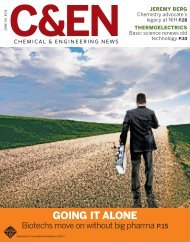Chemical & Engineering News Digital Edition ... - IMM@BUCT
Chemical & Engineering News Digital Edition ... - IMM@BUCT
Chemical & Engineering News Digital Edition ... - IMM@BUCT
Create successful ePaper yourself
Turn your PDF publications into a flip-book with our unique Google optimized e-Paper software.
minimize that risk, Smithsonian scientists<br />
used a metal screen to reinforce the part of<br />
the squid attached to the main restraining<br />
bracket and broad transparent straps to<br />
better distribute tension on the tentacles,<br />
says Michael Vecchione, a zoologist and<br />
Sant Ocean Hall curator. “The edges of the<br />
straps could still cut into the tissue,” he<br />
admits. To avoid these challenges, “ideally,<br />
you’d want a storage fluid that has the same<br />
density as seawater,” he comments.<br />
IN ADDITION, because Novec has a high<br />
vapor pressure and boils at a lower temperature<br />
than ethanol, museum staff had to<br />
take extra precautions to minimize evaporation,<br />
including using specially designed<br />
jars that could keep an extra-tight seal on<br />
the specimen and lighting that does not<br />
give off a lot of heat, Musteen says.<br />
“Will we ever abandon alcohol entirely?”<br />
Musteen asks. “No, mostly because we<br />
don’t have 200 years to test new things<br />
out.” For all the flaws of the established<br />
technology, museum experts know that<br />
formalin and ethanol keep specimens preserved<br />
for the long haul, Musteen says. For<br />
“Will we ever abandon alcohol entirely?<br />
No, mostly because we don’t have<br />
200 years to test new things out.”<br />
that reason, the Smithsonian doesn’t currently<br />
store one-of-a-kind or other highly<br />
valuable specimens in Novec. “People<br />
know that if they put a specimen into formalin<br />
or ethanol it’ll still be there” for years<br />
to come, Spatola says.<br />
Despite the challenges that come with<br />
using Novec, Simmons emphasizes that<br />
it offers some improvements over established<br />
fluids. For one thing, he notes, it remains<br />
clear while preserving a specimen’s<br />
color. And Novec’s nonflammability is a<br />
significant plus, he says.<br />
Tests on the giant squid and Novec continue,<br />
even while the animal is on display.<br />
Every organization that donated specimens<br />
for the new exhibition had the same<br />
request: “They wanted us to get lots of data<br />
on Novec fluid,” Musteen says. “They are<br />
looking for alternatives to alcohol, just like<br />
we are.” Specially designed needle ports<br />
in the squid’s display case permit periodic<br />
sampling of the squid’s tissue and the surrounding<br />
fluid. The sampling is “similar<br />
to the sort of biopsy a person might get to<br />
test for cancer,” Musteen explains. Smithsonian<br />
experts will test the Novec fluid to<br />
see whether any compounds are leaching<br />
from the squid and examine the squid’s<br />
tissue under the microscope to check for<br />
changes to cellular structure.<br />
“I’m excited to see the Smithsonian’s<br />
staff tackle fundamental issues in fluid<br />
preservation,” Simmons says, but he cautions<br />
that it will take a long time to build<br />
a reliable knowledge base about Novec or<br />
any new fluid that might come along. “This<br />
is very much an experiment,” Vecchione<br />
says. “We’re very interested in seeing how<br />
it will all turn out.” ■<br />
[ FAST CLEANUP OF<br />
SYNTHESIS REACTIONS ]<br />
Q Efficient Fractionation<br />
Q Cost Effective<br />
PoraPak TM<br />
Post Synthesis Cleanup<br />
©2008 Waters Corporation. Porapak and The Science of<br />
What’s Possible are trademarks of Waters Corporation.<br />
PoraPak Rxn products are designed to ensure fast and thorough cleanup of most synthesis<br />
reactions. The polymer used in PoraPak Rxn material is tolerant of pH extremes, shows low<br />
hydraulic resistance and displays very little shrinking or swelling in organic solvents. This<br />
combination of physical and chemical properties makes PoraPak Rxn an ideal solution for<br />
your most challenging synthesis cleanup.<br />
www.waters.com/medicinalchemists<br />
WWW.CEN-ONLINE.ORG 29 NOVEMBER 3, 2008

















